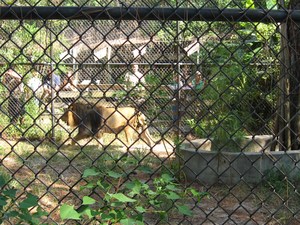You probably think of lions as wild beasts from Africa, but scientists have put together a family tree for cats placing their origin in South East Asia around 11 million years ago. Until 10,000 years ago, the lion was the most widespread, large-land mammal beside man. Asiatic lions, a subspecies that split from African lions, hang on by a small thread. India is their home now, for the 300 or so lions remaining, in a sanctuary called Gir National Forest. The Indian princes protect them, much to the dismay of the local farmers, until they are hunted down for “sport.
If you do a DNA fingerprint; Asiatic lions actually look like identical twins because they descend from as few as a dozen individuals. Inbreeding results in poor fertility. Lions copulate about 500 times for every litter produced. Not so much on account of prowess but to compensate for 70 to 80% of sperm being deformed due to lions’ small gene pool. Lions are inactive about 20 hours per day. Possibly, to rest up for their mating bouts.
Asiatic lions have long adorned currency and coats of arms as symbols of nations and nobility. A tiny, 5,000-year-old limestone sculpture depicting a lioness sold for 57.2 million dollars in 2007. The artwork crafted from ancient Mesopotamia was purchased by an anonymous buyer from England. To view one of the most awesome wildlife video of lions with a surprise ending-http://www.asterpix.com/console/?avi=7660461
In 1994, canine distemper killed more than a third of Africa’s Serengeti lions- a thousand animals. Researchers at the University of Leeds have made a breakthrough in understanding the virus. Distemper poses one of the greatest global disease threats to wild carnivores. The scientists have discovered how canine distemper jumps across and infects different species including lions.
Females are the primary hunters although the males usually eat first. Lions usually don’t seek out humans as prey but they have been known to develop a taste for human flesh. Such as in the 1898, Tsavo Man-Eaters case. During construction of a bridge over the Tsavo River for the Kenya-Uganda railway; two large, mane-less male lions killed and ate about 140 railroad workers over a course of nine months. The lack of a mane is found in inbred populations.
The Man-Eaters were always able to avoid capture, crawling through barriers and traps set for them. An engineer overseeing the bridge’s construction, was finally able to shoot and kill the lions. The movie the Ghost and the Darkness is about the Tsavo events. The stuffed bodies of the lions were on display at Chicago Field Museum but the National Museum of Kenya has demanded return to Nairobi. For more about lions and other animals:
http://www.associatedcontent.com/user/17928/randy_inman.html
The lion loves to eat a lot of red and tender meat. The hunter is trying to entice him from his lair, but the lion will not say which meat is his favorite. Is it crispy pork or rabbit-pie? Is it curried beef or a big plump hen? The lion finally answers, “The meat I am about to chew is neither steak nor chops- It’s You.”- Roald Dahl
Sources:
http://www.lionlamb.us/gandd.html
http://www.sciencedaily.com/releases/2007/10/071025094914.htm
http://www.asiatic-lion.org/intro.html

